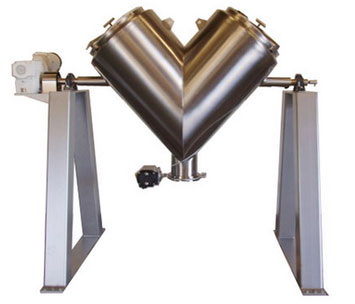V Blenders
V-Blenders designs are most often used for the intimate dry blending of free flowing solids. The solids being blended in these units can vary in bulk density and in percentage of the total mixture. Materials being blended are constantly being split and intermixed as the shell rotates. Normal cycle times are typically in the range of 15 minutes, however can be less depending on the difficulty of blending.
Our V-Blenders are stocked in 5, 10, and 15 cu.ft. Capacity. Each is constructed of type 316-stainless steel and is internally polished to a 240 grit sanitary finish. The exterior is polished to an easily cleaned 150-grit finish.
Alesol’s V-Blenders are supplied with Intensifier bars to permit de-agglomeration as needed. Discharge is accomplished through a manually operated Butterfly valve. The valve is positioned 24” from the floor when in the bottom position. All units are provided with appropriate safety railings and appropriately interlocked
safety interlocks. Stop-Start and E-Stop Pushbuttons are included with all blenders.
For products having poor flow properties, a shell design having a 70° angle is available upon request.
Convertible models are available for the customer who does not have an immediate requirement for use of an agitator but has the possibility for future applications. This design includes a pre-machined blender idler shaft to accept bearing, seal assembly, and insertion of the agitator assembly. The Idler shaft hub ends are supplied with stainless steel caps and a motor base plate is installed on the support frame for future installation of the agitator drive. At the time of conversion, the agitator assembly complete with bearing and seal assemblies, motor, V-belt drive, and guard are furnished for installation without disrupting the equipment.
Our V Blenders can be furnished with a PLC controlled, automated drum loading system. With one full revolution of the blender, the entire contents of a product container (fiber, plastic or stainless steel drum) can be transferred into the blender and back into drums after mixing, in a dust-free operation. This system eliminates costly mezzanine platforms, and other feed systems which require special docking mechanisms that create risk of spillage.
During loading, the operator simply rolls the drum onto the roller conveyor, raises the lift cylinders to squeeze the drum against the valve discharge flange seal, and initiates the load cycle. The blender slowly rotates one revolution while automatically opening and closing the valve, and stopping at the zero position. The empty drum is lowered, and replaced with a full container to repeat the cycle until all contents are charged.
During discharging, an empty drum is positioned on the roller conveyor and sealed against the valve discharge flange seal. The operator opens/closes the valve to fill the drum, lowers the drum, and replaces with an empty drum to repeat the cycle until all contents have been discharged
Salient Features:
- Intensifier bars for de-agglomeration
- Atmospheric construction
- Type 316 stainless steel parts
- 150 grit exterior finish, mirror finish on internal surfaces
- Stainless steel support stands
- Manually operated butterfly discharge valves
- Safety railings
- PLC controlled, fully automatic load and discharge functions.
- Operator station supplied in stainless steel, watertight construction with "Touch Screen" operator interface display incorporating blend timers.
- All stainless steel roller conveyor and instrumentation tubing.
- Adjustable positioning cams with proximity sensors.
- Pneumatic controls supplied in stainless steel, watertight construction, pre-mounted to blender frame (or for remote mounting, as desired). Contains all pneumatic valves with pushbutton control for raising/lowering lift cylinders, and opening/closing discharge valve. Operator is removed from the lift platform area for safe operation.
- Sanitary butterfly discharge valve is clamped to the blender outlet for quick disassembly and with quick release design for ease of cleaning and maintenance. Valve flange seal can be customized to suit the customer's product container.
